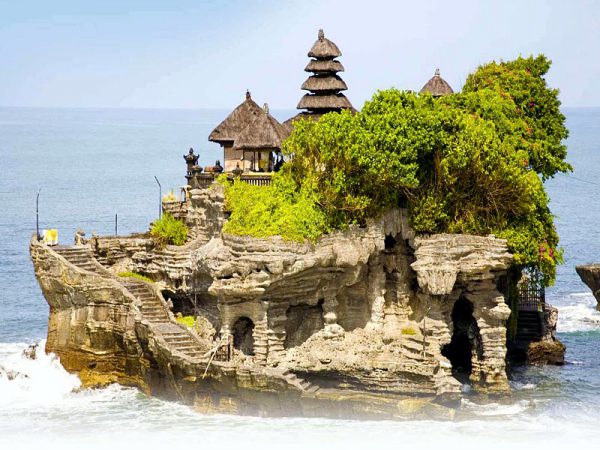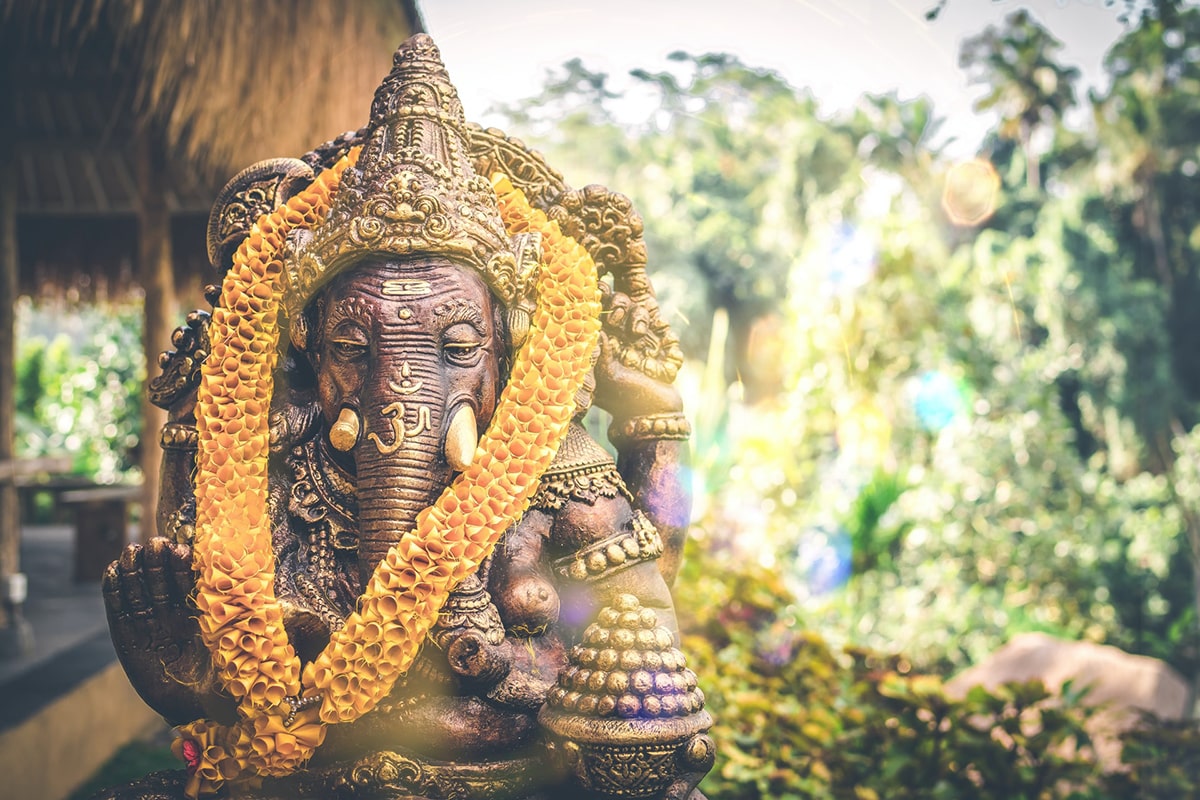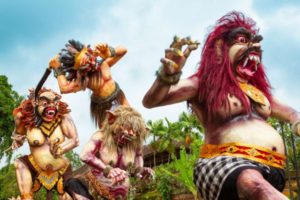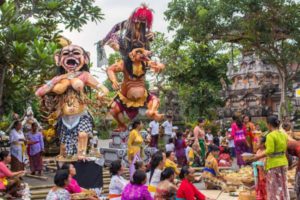Na klar! Es gibt viele Gründe!
Die Insel der Götter hat alles von Kultur, Bräuchen, Tempeln und Traditionen, vor und nach dem Tauchen, warme und einladende Einheimische, Festivals, Festlichkeiten, Wasserfälle, Wandermöglichkeiten, Luxus und Restaurants mit lokaler Küche. Es gibt viele luxuriöse Resorts und private Unterkünfte zur Auswahl, sowie preiswerte SPA-Erlebnisse bis hin zu integrativen Yoga-Kursen. Wenn Sie Lust auf einen Einkauf haben, dann finden Sie auf Bali alles von Burberry zu Bintang-Shirts.
Wir verstehen die Leute, die während ihres Urlaubs unter Wasser sein wollen, und wir werden später darüber im Blog reden, aber wenn man auch gerne die Orte, an denen man taucht, erkunden möchte, hat ein Bali-Zwischenstopp für jedes Budget und Interesse etwas zu bieten.
Die folgende Liste enthält keineswegs alles, was in Bali zu sehen und zu unternehmen ist. Wir haben versucht, Ihnen eine Vorstellung davon zu geben, was verfügbar ist. Nach 20 Jahren in Bali haben wir herausgefunden, dass unsere Tauchgäste oft mit angenehmen Erlebnissen von folgenden Orten kommen.
Tempel und Traditionen
Sie wollen Ihre nicht-tauchenden Freunde und Familienmitglieder nicht mit 500 Unterwasser-Fotos langweilen. Machen sie einen Zwischenstopp in Bali und sehen Sie sich ein paar balinesische Tempel während Ihres Tauchurlaubs an.

Tanah Lot
Der Tanah Lot Tempel ist eines der bedeutendsten Wahrzeichen Balis, berühmt für seine einzigartige Küstenlage und seine Sonnenuntergangs-Kulisse. Ein alter hinduistischer Schrein, auf einem Vorsprung an dem sich ständig Wellen brechen. Der Tanah Lot Tempel ist eine Ikone unter Balis Sehenswürdigkeiten.
Uluwatu
Der Uluwatu-Tempel oder Pura Luhur Uluwatu ist einer von sechs Schlüsseltempeln, die vermutlich die spirituellen Säulen von Bali sind. Er sitzt auf einer steilen Klippe etwa 70 Meter über dem Meeresspiegel mit herrlichem Meerblick im Westen. Dies macht Ihn zu einem fantastischen Ausflugsort, um den lokalen Kecak (Feuertanz) bei Sonnenuntergang, gefolgt von einem üppigen Abendessen zu sehen.
Goa Gajah
Das aus dem neunten Jahrhundert stammende Goa Gajah (Elefantenhöhle) ist eine archäologische Stätte von bedeutendem historischem Wert. Aber es ist auch ein wirklich cooler zu erkundender Ort. Nehmen Sie sich eine Stunde Zeit, um in seinen von Reliquien geschmückten Innenhof abzusteigen und die Felswand Schnitzereien, eine zentrale meditative Höhle, Bäder und Brunnen zu sehen.
Gunung Kawi Tempelkomplex
Einer der einzigartigsten archäologischen Stätten von Bali, bestehend aus einer Sammlung von zehn Candis (alte Schrein-Reliefs), die in Nischen einer Felswand geschnitzt sind. Die Frontseite mit Blick auf den heiligen Pakerisan Fluss, der auch durch den Tirta Empul Tempel einen Kilometer nach Norden fließt.
 Pura Ulun Danu Bratan
Pura Ulun Danu Bratan
Erbaut im Jahre 1926, ist es der zweitwichtigste Tempelkomplex von Bali, nach dem Haupttempel Pura Besakih. Der Tempel ist Dewi Batari Ulun Danu, Göttin von Seen und Flüssen gewidmet. „Ulun Danu“ übersetzt wörtlich als „Kopf des Sees“.
Tirta Gangga
Die großzügigen Wassergärten im Besitz der königlichen Karangasem-Familie verfügen über etwa 110 Meter an Pools, Teichen und Springbrunnen, umgeben von gepflegten Rasenflächen, die geschmückt mit Trittsteinen, reich verzierten Statuen und tropischen Gärten sind.
Monkey Forest
Neben dem Beobachten von spielerischen Affen in ihrem natürlichen Lebensraum, schwingend durch Vordächer, faulenzen entlang von Wegen oder bei der Fütterung mit Bananen, bietet die Anlage schöne Spaziergänge entlang auf gepflasterten Wegen durch einen grünen Muskatwald. Ein schöner alter Tempel mit Wächter Statuen bedeckt von Moos umgeben von Wald.
Kultur & Brauchtum
So haben Sie auch noch etwas anderes als nur über Ihre Taucherlebnisse zu reden, machen Sie Halt in Bali und lernen Sie ein wenig über die balinesische Kultur und deren Bräuche während Ihres Tauchurlaubs!
Die Balinesische Kultur ist eine Mischung balinesisch-hinduistischer Religion und lokalen Bräuchen. Weitere Religionen von Minderheiten sind Islam, Buddhismus und Christentum. Es ist vielleicht am besten für seine Tänze, theatralischen Aufführungen und Skulpturen bekannt. Auch in armen ländlichen Dörfern sind schöne Tempel ein willkommener Anblick, sowie geschickte Gamelan Spieler, talentierte Schauspieler und Tänzer. Die balinesische Kultur ist beeindruckend und die Einheimischen sind einige der wärmsten, freundlichsten Menschen, die Ihnen überall begegnen. Der Veranstaltungskalender des Bali Magazins ist eine gute Referenz für Zeremonien und Aufführungen sowohl groß als auch klein.
Melasti – March 25, 2017
Pilgrims take heirlooms on long walks from temples towards the coastlines where purification rites take place. Parasols, banners and small effigies paraded along the horizon make for a stunning and only-in-Bali scene.
Saka, New Year’s Eve March 27, 2017
A night of merriment and noise, every Balinese household starts the evening with blessings at the family temple and continues with a ritual to ‘chase away’ malevolent forces, known as bhuta kala, from their compounds – hitting pots and pans or any other loud instruments along with a fiery bamboo torch. These ‘spirits’ are later manifested as the ogoh-ogoh to be paraded in the streets. As the street parades ensue, bamboo cannons and occasional firecrackers fill the air with flames and smoke.
- Ogoh-ogoh Statues at the Ngrupuk Parade
Nyepi, Day of Silence – March 28, 2017
Nyepi Day in Bali is a New Year celebration unlike anywhere else on the planet. This day of silence is ultimately the quietest day of the year when all of the island’s inhabitants abide by a set of local rules, which brings all routine activities to a complete halt. The airport and roads all over Bali are devoid of any traffic and nobody steps outside of their home compounds
Gulangan and Kuningan – April 4th & November 1, 2017
Galungan enlivens the whole island of Bali with locally made Penjors (beautifully decorated bamboo poles) lining all the roads on the island. For 10 days this festival celebrates the creation of the universe; the victory of the good Dharma against the evil Adharma. It is believed that the gods come down to earth and ancestors’ souls pay a visit to their families.
Bali Arts Festival – June 10th through July 8th
The Bali Arts Festival is a cultural treat for lucky visitors who are in Bali around mid-July. It is the perfect moment to witness Bali’s wealth of artistic creativity together with various cultural highlights from other islands in Indonesia. It kicks off with a parade that showcases traditional costumes and culture from regions throughout Indonesia.
Smaller cultural performances are held regularly throughout the island but Ubud’s a great place to start looking, as it is Bali’s artistic heart.
Kecak and Trance Dance
The kecak is a ritual dance that was created for the 1933 movie „Island of the Demons“ by the German painter and intellectual Walter Spies, Victor Von Plessen and Friedrich Dalsheim. The dance combines the chorus of the „Sanghyang“ trance dance with a dance story from the Indian epic poem „Ramayana.“

Legong and Mahabharata
The Legong is a very difficult dance requiring great dexterity and is generally performed by young girls. The dance is choreographed to the finest detail with no improvisation allowed.
Barong and Kris Dance
The Barong is a triumphant display of graceful movement and vibrant color. The dance is a contest between the opposing forces of Rangda, representing chaos and destruction, and Barong, representing order.
Ramayana Ballet
This highly entertaining dance form plays out the epic legends of the Ramayana. The ballet tells an adventurous tale broken into four scenes that include kidnapping, travel, and death. The dancers do not converse with each other. The story is narrated only by the „sinden“, a female singer present throughout the piece.
Diving in Bali Before or After your Dive Holiday
Bali and the surrounding islands have amazingly diverse diving. We highly recommend that guests stopover and dive Bali before or after their dive trips in other parts of the archipelago. It’s a great place to get your feet wet, make sure your gear is working properly and see some amazing marine life that you may not see elsewhere. Starting clockwise let’s take a dive tour around Bali.
Northwest Bali
Day trips to dive the Northwest are not a good option as the distance is too great. You’ll want to book a place to stay somewhere near Pemuturan or Lovina (Kalibukbuk). From there you can easily access the popular sites in the area.
Most of the diving in the Northwest is located in two areas. Menjangan Island – Menjangan Island is a small island off the coast that is situated in the marine preserve of the Bali Barat National Park. If you are looking for coral and fish this is your place. It is known for walls and nice colorful reefs with lots of reef fish. Secret Bay – Incredible macro subjects await. Due to a stilty bottom and tides, viz can be limited, so go with someone who knows the area well. Another amazing „muck“ dive in the central region of the north is Puri Jati where your guides will be on the lookout for mimic octopus and other fun macro subjects.
Staying in the Area? If you plan to spend a week diving in North Bali, be forewarned that there just aren’t enough dive sites for 3 dives a day. Be prepared to spend a little time relaxing or doing some day excursions. If you are looking for a bit more action Lovina has some nightlife and restaurants in a central area, although it’s still sleepy compared to South Bali.
- Matahari Beach Resort and Spa
- Menjangan Resort or Taman Sari Bali
- Pondok Sari Beach Resort, Spa and Dive Center
- Tirta Sari (across from Pondok Sari dive center)
For a special treat check out Puri Jati Retreat. Located near the Puri Jati dive site this is a private villa owned by two divers that live and work in the Indonesian archipelago.
Northeast Bali
Tulamben
Although day trips are available from the south, why spend 1.5 – 3 hours each way in a car. Instead, you can go up, stay awhile, do some great diving, and enjoy the quiet mornings and spectacular sunrises that light up Mt. Agung. Plus night dives in Tulamben can be amazing and a two-hour drive home after isn’t going to be the highlight.
Central Tulamben (Liberty Wreck) and central Amed are only 45 minutes by car from each other. You can easily stay in one area and drive to the other depending on where the dive winds are blowing that day. Dive centers will generally set this up for an additional fee. While Tulamben attracts many of the divers in the Northeast, Amed is becoming more popular with people looking for smaller crowds.
Tulamben refers to a sprawling area with many beautiful sites to choose from. Most divers would agree that southern Tulabmen’s most famous „muck“ site is Sereya’s Secret, but Melasti is great too! Basically, that whole stretch of beach is super-productive for macro. Farther up the coast you don’t want to miss the U.S.S. Liberty. This WWII vintage, 120m long cargo vessel is covered with life. Farther still up the coast are Kubu Drop Off and Coral Gardens; both are easily accessible reef dives. Equally fabulous and less crowded are dive sites north near Baturinggit. Resorts there have secret „muck“ sites in addition to reef sites like Ulami and Out of Eden.
The following hotels have a reputable dive center located on property.
- Villa Markisa Dive Resort & Alam Batu Dive Resort – Both properties have standard rooms available for budget minded travelers
- Liberty Wreck in Tulamben
- Blue Hill Tulamben
Amed
Amed is a series of bays; each bay has a cluster of small hotels and home stays, restaurants, dive centers and shops. While less well known than its northern neighbor, Amed also has some diving gems. The highlight at Jemuluk Kayu Putih is a pinnacle that rises from 25m and has a scenic swim-through at 20m. Ghost Bay is the place for rare species like the clown frogfish, different kinds of ghost pipefish and mimic octopus. The Japanese Wreck, a 20m long patrol boat sunk during the war, rests in a lovely coral garden and is covered in soft corals and reef fish. The top of it, at only 3m is shallow enough to snorkel and the deepest part is just 12m so it’s perfect for an easy (and long) dive.
- Griya Villas Amed
- Arya Amed Beach Resort & Dive Center
- Baliku Dive Resort Amed
- Puri Wirata Dive Resort Amed
There are so many options for a stopover in Bali before or after your dive holiday that we can’t possibly cover them all in this blog. While we started our Bali dive tour in the Northwest, Part II will cover dive areas on Bali’s east coast and outlying islands. Part II will also have more information on trekking and sightseeing the natural wonders of Bali and of course, our favorite restaurant experiences and fun shopping ideas (some that are as much about culture as they are about souveniers). Link to our list of sailing dates to help plan your Bali stopover.









